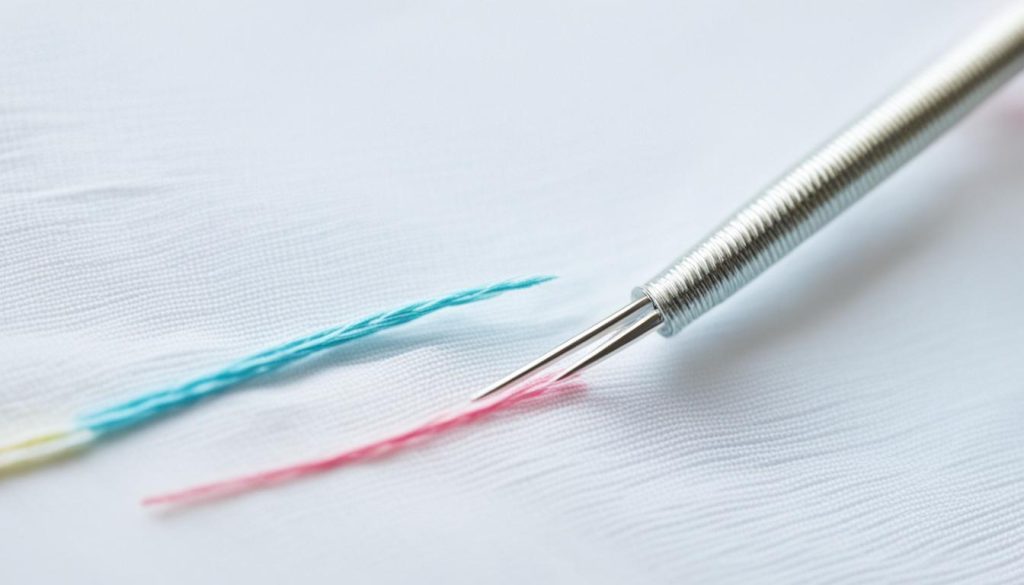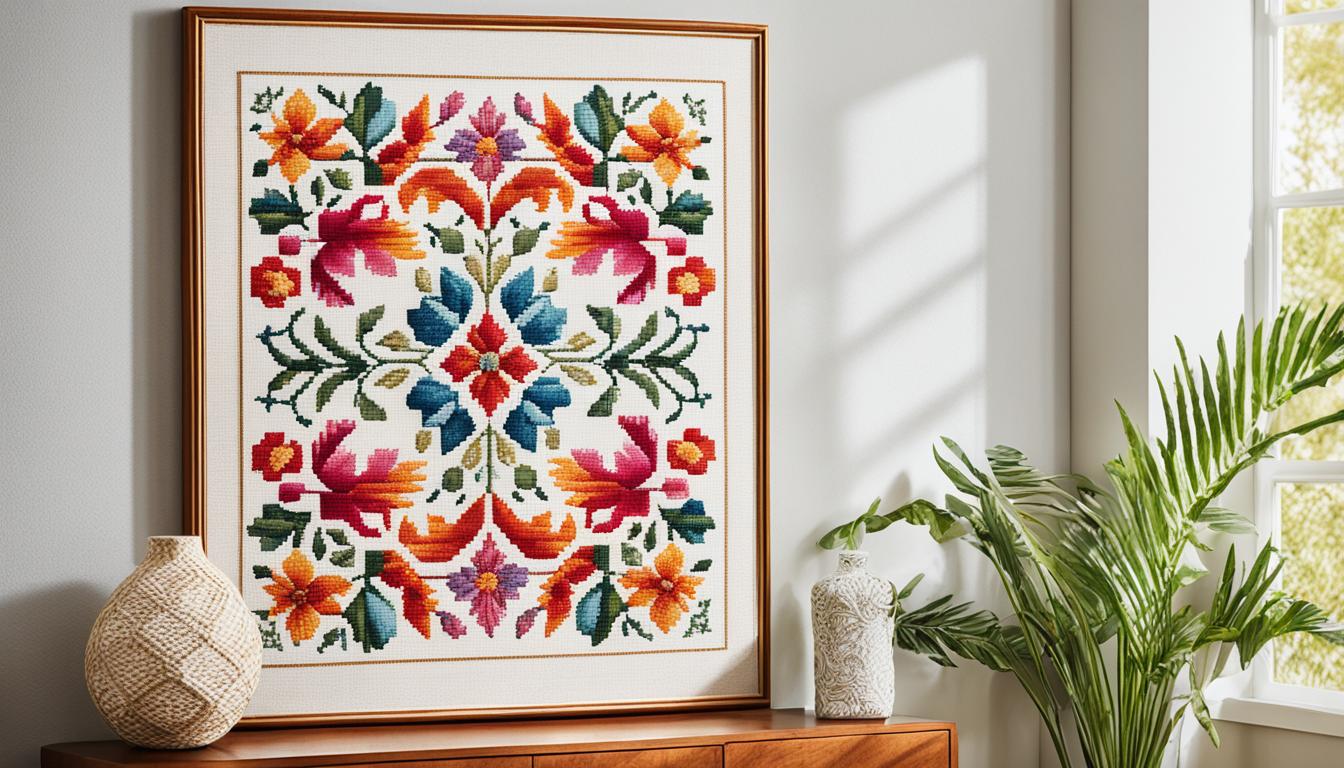Do you think your detailed cross stitch work might be more valuable than you know? Even though cross-stitch patterns can be cheap, the effort and style you add can make your work worth a lot. Some patterns are sold from $5 to $20, and more intricate ones can cost even more. Finding out the true worth of your handmade cross stitch might surprise you.
If you love cross-stitching, it’s vital to think about the value of your creations. Choose your patterns wisely from places like Peacock & Fig. This helps the original designers and could make your work more valuable. Here’s a way to see if your cross-stitch pictures might be valuable.
Key Takeaways
- Cross stitch patterns typically sell for $5 to $20.
- High-quality, reputable sources ensure better pattern value.
- Avoid swapping patterns to support original designers.
- Patterns sold for extremely low prices may be stolen or of bad quality.
- Your detailed craftsmanship can significantly increase the value of your handcrafted cross stitch.
The Hidden Value of Your Cross Stitch Art
Looking into the value of your cross stitch reveals a lot. Cross stitch has a long history, going back to ancient Egypt. Since then, it has fascinated people, making its pieces very valuable.

Understanding Market Demand
Cross stitch’s value comes from its quality work, unique themes, and history. It became famous in the 1960s, growing in popularity since. Its simple techniques make it easy for beginners to learn.
Popular Themes and Patterns
Collectors often look for cross stitch patterns with modern themes. This includes things like flowers, animals, and famous quotes. There are also patterns for babies, weddings, and holidays such as Christmas and Halloween.
Groups in the community have introduced 3D designs and new materials like metallic threads. These additions bring fresh looks to traditional patterns.
Historical and Vintage Appeal
Old and vintage cross stitch works are very appealing. Pieces from as far back as the 1500s have a special charm. This is because of their detailed designs and historic value. Well-known brands like DMC are also important because of their good threads.
The interest in cross stitch grew during the 1800s thanks to the Arts and Crafts Movement. Now, with apps and eco-friendly methods, it keeps its appeal. Both new and experienced stitchers find it engaging.
Evaluating Your Cross Stitch Collection
When you want to know the value of your cross-stitch collection, look at several things. You need to check every piece closely in different ways.
Assessing Craftsmanship and Detail
How well stitches are done and the threads used are key. A cross-stitch work that is full of detail and careful work can take up to 225 hours. It shows a lot of time and skill are put into it. Look at how neat the stitches are, how even the threads look, and the design itself. This shows how much skill and effort went into making it.
Rarity and Uniqueness of Patterns
If a cross-stitch design is rare, it can make your collection worth more. Designs that are not made anymore or are very limited can be more valuable. It’s also important to see how unique the design is. Plus, how much people like that design can affect its value too.

Condition and Preservation
Taking care of your cross-stitch pieces is very important. Check them for any damage or signs of wear. Keep them in a place that’s not too hot, not too cold, and away from wetness and direct sun. Using materials that won’t harm your art and keeping an eye on them can help avoid damage.
Looking at craftsmanship, rarity, and condition will help you figure out your collection’s value. This way, you can make sure your cross-stitch pieces keep their worth and remain attractive.
Where to Sell Your Cross Stitch Pieces
When it comes to selling your cross-stitch art, choosing the right place is key. You can sell online, join forums, or visit craft fairs. Each way has its own benefits for connecting with buyers.
Popular Online Marketplaces
Etsy and eBay are great for selling your pieces. Etsy takes about 5% from each sale but offers a lot of visitors. eBay takes a 10% cut. If you prefer your online shop, Shopify and SquareSpace are good. They charge from 2% to 10% and $15 per month. Etsy has a large audience, while Shopify lets you make a unique store.
Community Forums and Cross Stitch Communities
Forums and communities are another way to sell. Reddit’s r/CrossStitch and 123Stitch.com forums link you with fans. They offer a place to share your work, get advice, and make sales. Being active in these groups can also help by word of mouth and trust.
Local Craft Fairs and Exhibitions
Local fairs let you meet buyers in person. They give customers a chance to see your work up close. While it costs money to set up, the chance to sell directly makes it worthwhile. Look in local papers for craft fair events to join.
Choosing where to sell is important. You can sell online, in forums, or at fairs. Know your buyer and set the right price. Good customer service always helps you grow in the cross-stitch market.
Cross Stitch: How To Identify and Avoid Bad Patterns
Knowing about crossstitching pattern quality is key for anyone who wants their work to shine. Many patterns are cheap, starting at $4.95, but not all lead to great finishes.  When figuring out if a cross stitch design is bad, look at customer reviews. Patterns like the Octopus Tea from Etsy can give you an idea of what to avoid.
When figuring out if a cross stitch design is bad, look at customer reviews. Patterns like the Octopus Tea from Etsy can give you an idea of what to avoid.
Pay attention to the stitch and color counts. Good patterns offer detailed guides for each stitch and color. These guides lead to a more polished finished product. When you compare patterns, brighter and clearer designs stand out. They make your work look much better than simple or vague designs.
Avoid patterns that are too cheap. They could be stolen or not licensed correctly. It’s best to get your patterns from trusted sources. This way, the details and quality of the design are guaranteed.
Also, look at what other stitchers are saying. Patterns that people consistently love for their clarity and detail are safer choices. This information can help steer you away from patterns that won’t meet your standards.
Here is a quick look at the main points for picking good or bad crossstitching patterns:
| Aspect | Good Pattern | Bad Pattern |
|---|---|---|
| Stitch and Color Count | Detailed and Clear | Overly Simplistic |
| Price | Reflective of Quality | Suspiciously Low |
| Customer Reviews | Generally Positive | Mixed or Negative |
| Reputation of Source | Established and Reputable | Unknown or Questionable |
With these tips, you can make sure you’re choosing high-quality patterns. This will prevent the frustration of bad patterns. Choosing a good pattern from a trustworthy source can make your cross-stitching more enjoyable. Plus, it ensures your art is beautiful and lasts a long time.
The Role of Cross Stitch Supplies in Determining Value
For your cross stitch projects to last and look good, essential cross stitch supplies are key. The fabric you use, the brand of thread, and the needles all matter. Using the best supplies helps your project come out perfect and increases its value.
Aida cloth is a top choice because it’s easy to see and count stitches. When picking crossstitching fabric, choose one that matches your design and skill level. DMC thread stands out for its vibrant colors and longevity. Opting for a trusted brand keeps your work looking great for longer.
It’s best to use size 24 tapestry needles for most projects. They’re good because they don’t damage the fabric and hold the thread well. Having a good hoop to stretch your fabric tight also makes your work neater.
Buying high-quality cross stitch accessories like bright magnifiers and thimbles can make a big difference. They help you work better and more comfortably. This leads to better results and can increase the value of your piece.

- Essential Cross Stitch Supplies: On average, you might spend $237 for a project. This includes quality fabric, thread, needles, and hoops.
- Pricing Based on Stitches: Charging 1 to 5 cents per stitch could bring the cost of a bigger project to over $10,000.
- Calculating Project Costs: For a 400 x 509 stitch project, costs could range from $10,180 to $15,000 when factoring in materials.
| Factor | Impact on Value |
|---|---|
| Cross Stitch Fabric | Determines ease of stitching and final appearance. |
| Stranded Cotton Floss | Ensures vibrant colors and durability. |
| Tapestry Needles | Facilitates smooth stitching without fabric damage. |
| Cross Stitch Hoops | Keeps fabric taut for precision. |
| High-Quality Accessories | Enhances efficiency and overall quality. |
Your crossstitching projects show how dedicated and skilled you are. Using high-quality crossstitching accessories enhances your enjoyment and the value of your work. Choose your supplies carefully to make sure your art is always highly valued.
Conclusion
Cross-stitching isn’t just a hobby. It’s a blend of personal heart and potential value. You can make it a rewarding journey by knowing what the market wants. Think about every detail of your designs. And always pick the best supplies.
Learning from mistakes is a big part of improving. It shows us why we need to be precise and patient. This craft teaches us to carefully follow instructions to avoid mistakes. It challenges us to be detail-oriented, improving our hand-eye coordination.
But, cross-stitching is also calming. It’s great for unwinding and focusing. It lets us be creative and give unique gifts. Getting into cross-stitching means making memories and friends. It boosts our brain and helps with stress. The value of your art is more than its beauty. It’s about the joy and peace it brings.
